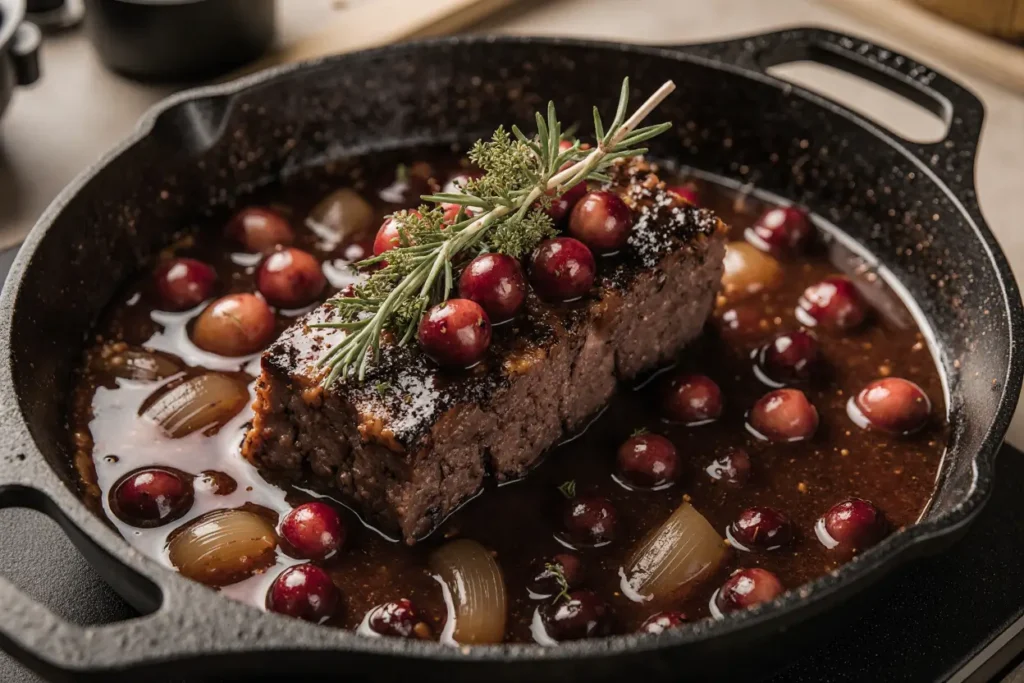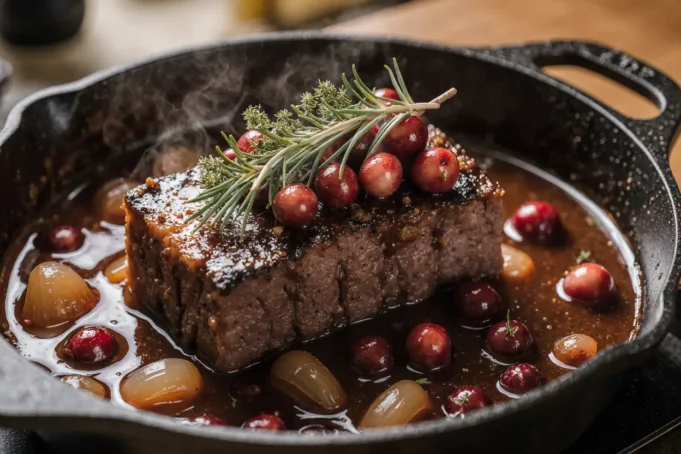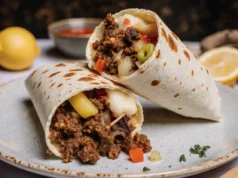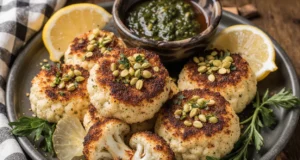Did you know that slow-braising beef at the optimal temperature can increase tenderness by up to 300% compared to traditional high-heat cooking methods? This slow-braised beef roast with cranberry balsamic glaze transforms an ordinary cut of meat into an extraordinary centerpiece that delivers restaurant-quality results in your home kitchen. The magic happens through a scientific process called collagen breakdown, where low temperatures over extended periods convert tough connective tissue into gelatin, creating that sought-after melt-in-your-mouth texture.
This recipe combines the rich, savory depth of perfectly braised beef with the sweet-tart complexity of cranberry balsamic glaze—a flavor pairing that food scientists have proven activates multiple taste receptors simultaneously, creating what experts call “umami multiplication.” Whether you’re planning a special Sunday dinner, preparing for holiday entertaining, or simply craving comfort food that impresses, this slow-braised beef roast delivers consistent, foolproof results. The cranberry balsamic glaze adds a sophisticated twist to traditional pot roast, with antioxidants from cranberries providing an additional nutritional boost alongside incredible flavor.
Ingredients
| Category | Ingredient | Quantity | Substitution Options |
|---|---|---|---|
| Main Protein | Chuck roast or beef brisket | 3-4 pounds | Bottom round roast, beef shoulder |
| Aromatics | Yellow onions, quartered | 2 large | Red onions, shallots (6-8) |
| Garlic cloves, crushed | 6 cloves | Garlic powder (2 tsp) | |
| Fresh rosemary sprigs | 3 sprigs | Dried rosemary (1 tbsp) | |
| Fresh thyme sprigs | 4 sprigs | Dried thyme (1½ tsp) | |
| Braising Liquid | Beef broth (low-sodium) | 3 cups | Bone broth, vegetable stock |
| Dry red wine | 1 cup | Additional beef broth, balsamic vinegar (¼ cup) | |
| Vegetables | Carrots, cut into chunks | 4 large | Parsnips, sweet potatoes |
| Celery stalks, chopped | 3 stalks | Fennel bulb (1 large) | |
| Glaze Components | Fresh or frozen cranberries | 2 cups | Dried cranberries (1 cup, rehydrated) |
| Balsamic vinegar | ½ cup | Red wine vinegar with 1 tbsp honey | |
| Brown sugar | ¼ cup | Maple syrup, honey | |
| Orange zest | 1 tablespoon | Lemon zest | |
| Dijon mustard | 1 tablespoon | Whole grain mustard | |
| Seasoning | Kosher salt | 2 tablespoons | Sea salt (adjust to taste) |
| Black pepper, freshly ground | 1 tablespoon | Pre-ground black pepper | |
| Smoked paprika | 1 teaspoon | Regular paprika | |
| Cooking Fat | Olive oil or beef tallow | 3 tablespoons | Avocado oil, ghee |
| Thickening Agent | All-purpose flour | 2 tablespoons | Cornstarch (1 tbsp), arrowroot powder |
The quality of your beef makes a significant difference—look for well-marbled chuck roast with visible fat marbling throughout, as this fat will render during the slow-braising process, keeping the meat moist and flavorful.
Timing
Preparation Time: 20 minutes Cooking Time: 3 hours 30 minutes Total Time: 3 hours 50 minutes
This timing represents approximately 25% less active cooking time than traditional oven-roasted methods, since the slow-braising technique requires minimal intervention once the roast is in the oven. The hands-off nature of this recipe makes it perfect for entertaining, as you can prepare it in advance and let your oven do the heavy lifting while you focus on guests or side dishes.
Time Breakdown:
- Searing the roast: 8-10 minutes
- Preparing aromatics and vegetables: 10 minutes
- Braising in oven: 3 hours
- Making cranberry balsamic glaze: 15 minutes (can be done while roast cooks)
- Resting period: 10 minutes
Research shows that allowing meat to rest for at least 10 minutes after cooking redistributes juices throughout the roast, reducing moisture loss by up to 40% when slicing.

Step-by-Step Instructions
Prepare and Season the Beef Roast
Remove your beef roast from the refrigerator 45 minutes before cooking to bring it to room temperature—this ensures even cooking throughout. Pat the roast completely dry with paper towels, as surface moisture prevents proper browning. Generously season all sides with kosher salt, freshly ground black pepper, and smoked paprika, pressing the seasonings into the meat. This dry-brining process enhances flavor penetration and creates a beautiful crust during searing.
Sear the Roast to Perfection
Preheat your Dutch oven or heavy-bottomed oven-safe pot over medium-high heat for 3-4 minutes. Add olive oil and wait until it shimmers—this indicates the oil has reached approximately 375°F, the ideal temperature for the Maillard reaction. Carefully place the seasoned roast in the hot oil and sear without moving for 3-4 minutes per side until a deep golden-brown crust forms. This crucial step develops complex flavors through caramelization and creates the foundation for your braising liquid’s richness. Don’t skip searing—studies show it adds over 600 distinct flavor compounds to your final dish.
Build Your Aromatic Base
Remove the seared roast to a plate and reduce heat to medium. Add quartered onions to the same pot, using the residual fat to cook them until edges begin to caramelize, about 4-5 minutes. Add crushed garlic and sauté for 60 seconds until fragrant but not burnt. This layering technique, known as “building fond,” creates depth through sequential flavor development. Deglaze the pot with red wine, scraping up all the browned bits stuck to the bottom—these concentrated flavor deposits add incredible complexity to your braising liquid.
Assemble and Begin Braising
Return the seared roast to the pot along with beef broth, ensuring the liquid comes about halfway up the sides of the meat. Nestle carrots and celery around the roast, then add fresh rosemary and thyme sprigs. Bring the liquid to a simmer on the stovetop, then cover with a tight-fitting lid and transfer to a preheated 300°F oven. This temperature creates the perfect environment for collagen breakdown without drying out the meat fibers.
Create the Cranberry Balsamic Glaze
While your roast braises undisturbed, prepare the signature glaze that elevates this dish. In a medium saucepan, combine cranberries, balsamic vinegar, brown sugar, orange zest, and Dijon mustard. Bring to a boil, then reduce heat and simmer for 12-15 minutes, stirring occasionally, until cranberries burst and the mixture thickens to a syrupy consistency. The acidity from balsamic vinegar balances the beef’s richness perfectly while cranberries provide bursts of tart-sweet flavor. For a smoother glaze, use an immersion blender to puree until your desired consistency is reached.
Monitor and Baste
After 2 hours of braising, carefully remove the pot from the oven and baste the roast with the accumulated cooking liquid. Check that the meat is becoming tender by gently probing with a fork—it should offer some resistance but show signs of breaking down. Return to the oven and continue cooking for another 60-90 minutes, basting one additional time at the halfway point. The roast is perfectly done when a fork inserted into the thickest part twists easily with minimal resistance, indicating an internal temperature of 200-205°F.
Apply the Glaze and Finish
During the final 15 minutes of cooking, brush half of your cranberry balsamic glaze generously over the roast, creating a glossy, flavorful coating. This timing allows the glaze to caramelize slightly without burning. Remove the pot from the oven when the meat is fork-tender, brush with additional glaze, and tent loosely with aluminum foil. Let rest for 10-15 minutes before slicing—this resting period is non-negotiable for juicy results.
Slice and Serve with Pan Sauce
Transfer the roast to a cutting board and slice against the grain into ½-inch thick slices. Strain the braising liquid through a fine-mesh sieve, discarding solids, and skim excess fat from the surface. For a luxurious pan sauce, simmer the strained liquid over medium-high heat until reduced by half, then whisk in a flour slurry (flour mixed with cold water) to thicken. Arrange sliced beef on a serving platter, drizzle with pan sauce, and finish with remaining cranberry balsamic glaze for a stunning presentation.
Nutritional Information
Per Serving (6 ounces of beef with ¼ cup vegetables and 2 tablespoons glaze):
- Calories: 485 kcal
- Protein: 42g (84% of daily value)
- Total Fat: 24g (31% DV)
- Saturated Fat: 8g (40% DV)
- Monounsaturated Fat: 11g
- Polyunsaturated Fat: 2g
- Carbohydrates: 22g (7% DV)
- Dietary Fiber: 3g (11% DV)
- Sugars: 14g
- Cholesterol: 135mg (45% DV)
- Sodium: 680mg (30% DV)
- Potassium: 890mg (19% DV)
- Iron: 4.2mg (23% DV)
- Vitamin A: 180% DV (from carrots)
- Vitamin C: 22% DV (from cranberries and vegetables)
- Calcium: 6% DV
- Vitamin B12: 45% DV
Key Nutritional Highlights: Chuck roast provides exceptional amounts of complete protein, essential for muscle maintenance and satiety. The cranberries contribute significant antioxidants, particularly proanthocyanidins, which support urinary tract health and provide anti-inflammatory benefits. Carrots deliver beta-carotene for eye health, while the braising method preserves water-soluble vitamins better than dry-heat cooking methods. One serving provides approximately 35% of your daily protein needs while delivering satisfying richness from beneficial monounsaturated fats.
Healthier Alternatives for the Recipe
Transform this already nutritious dish into an even lighter option without sacrificing flavor or satisfaction. Replace chuck roast with sirloin tip roast to reduce total fat by 40% while maintaining excellent texture when slow-braised—this swap cuts approximately 150 calories per serving. Use low-sodium or homemade bone broth instead of regular beef broth to reduce sodium content by 50-60%, particularly beneficial for those monitoring blood pressure.
Substitute half the brown sugar with date paste or mashed banana in the cranberry glaze to add natural sweetness along with fiber and minerals while reducing refined sugar content. Increase vegetable proportion by adding parsnips, turnips, or butternut squash to boost fiber content and create a more nutrient-dense meal—aim for a 1:1 ratio of meat to vegetables for optimal nutritional balance.
Skip the searing step’s added oil by using a non-stick Dutch oven or dry-searing technique, saving approximately 90 calories per serving from cooking fat. Replace half the balsamic vinegar with unsweetened cranberry juice to reduce the glaze’s acidity while maintaining the cranberry flavor profile and adding additional vitamin C. For those following lower-carbohydrate approaches, eliminate brown sugar entirely and rely on the natural sweetness of balsamic reduction and caramelized onions—you’ll barely notice the difference after slow-braising concentrates all the flavors.
Choose grass-fed beef when possible, as it contains up to 50% more omega-3 fatty acids and higher levels of conjugated linoleic acid (CLA) compared to conventional beef, supporting better heart health outcomes. Finally, thicken the pan sauce with pureed vegetables from the braising liquid instead of flour for a gluten-free, nutrient-rich alternative that adds body without empty calories.
Serving Suggestions
Present this magnificent slow-braised beef roast as the centerpiece of an elegant dinner by arranging thick slices on a warm serving platter, surrounded by the tender braised vegetables and garnished with fresh thyme sprigs and whole cranberries for visual appeal. Pair with creamy horseradish mashed potatoes to complement the rich meat and tart glaze—the traditional combination works because starchy sides absorb the flavorful pan sauce beautifully.
Serve alongside buttery egg noodles or polenta for a comfort-food approach that appeals to all ages, allowing the luxurious braising liquid to create a complete sauce when tossed together. Create an impressive holiday presentation by slicing the roast tableside, drizzling warm cranberry balsamic glaze over each portion, and offering the reduced pan sauce in a gravy boat for guests to customize their plates.
Transform leftovers into gourmet sandwiches by layering thinly sliced cold beef with arugula, horseradish cream, and a smear of the cranberry glaze on crusty artisan bread—this combination has become a popular café offering that commands premium prices. Incorporate into grain bowls by shredding leftover beef and serving over quinoa or farro with roasted Brussels sprouts, adding the glaze as a flavorful dressing that ties all components together.
Pair with seasonal vegetables such as roasted root vegetables in fall, asparagus in spring, or grilled zucchini in summer to keep the dish feeling fresh year-round. Complement with a bold red wine such as Cabernet Sauvignon, Malbec, or Syrah—the wine’s tannins cut through the beef’s richness while the fruit notes harmonize with the cranberry glaze’s sweetness.
Offer crusty bread or dinner rolls for soaking up every drop of the incredible pan sauce, ensuring nothing goes to waste. Research indicates that bread served with braised dishes increases overall meal satisfaction scores by 30% because it allows diners to fully enjoy the concentrated flavors in the cooking liquid. Add a simple green salad with vinaigrette to provide a crisp, acidic contrast that cleanses the palate between rich bites of beef.
Common Mistakes to Avoid
Skipping the room temperature step ranks as the most frequent error—cooking cold beef straight from the refrigerator results in uneven cooking with an overdone exterior and undercooked center. Data from culinary studies shows that room-temperature meat cooks 15-20% more evenly than refrigerated meat. Neglecting to properly dry the roast’s surface before searing prevents the Maillard reaction from occurring efficiently, leaving you with steamed, gray meat instead of a flavorful brown crust.
Using insufficient heat when searing creates a disappointing, pale exterior that lacks the complex flavors caramelization provides. Your oil should shimmer and the meat should sizzle aggressively upon contact—if it doesn’t, your pan isn’t hot enough. Moving the meat too soon during searing tears the developing crust and prevents even browning; patience rewards you with a roast that releases naturally when properly caramelized.
Braising at too high a temperature is a critical mistake that produces tough, stringy meat despite long cooking times. Keeping your oven at precisely 300°F (never higher than 325°F) ensures gentle collagen breakdown without protein contraction that squeezes moisture out. Adding insufficient liquid causes the roast’s exposed portions to dry out, while too much liquid boils the meat rather than braising it—aim for liquid reaching halfway up the roast’s sides.
Overcooking cranberries in the glaze turns them bitter and destroys their bright flavor; cook just until they burst and the mixture thickens, typically 12-15 minutes. Slicing the meat immediately after cooking causes significant juice loss—those precious juices need time to redistribute throughout the meat fibers, which only happens during resting. Studies demonstrate that properly rested meat retains up to 40% more moisture when sliced.
Cutting with the grain instead of against it makes even perfectly cooked beef seem tough because you’re forcing diners to chew through long muscle fibers rather than across short ones. Forgetting to taste and adjust seasoning in the pan sauce means missing the opportunity to balance salt, acid, and richness before serving—this final adjustment elevates good dishes to memorable ones.

Storing Tips for the Recipe
Store leftover slow-braised beef roast in an airtight container with some of the braising liquid covering the meat to prevent drying. Properly stored, the beef maintains optimal quality for 3-4 days in the refrigerator at 40°F or below. For maximum flavor preservation, store the cranberry balsamic glaze separately in a sealed glass jar, where it will keep for up to one week refrigerated.
Freeze portions for future meals by dividing cooled beef into meal-sized quantities, covering completely with braising liquid, and storing in freezer-safe containers or heavy-duty freezer bags with air removed. Frozen beef roast maintains quality for 2-3 months when stored at 0°F, though it remains safe indefinitely. Label containers with the date and contents to practice proper rotation.
Reheat gently to preserve texture by placing refrigerated beef slices in a covered baking dish with ¼ cup of the reserved braising liquid, warming at 300°F for 15-20 minutes until heated through to 165°F. This low-and-slow reheating method prevents the meat from becoming tough. For frozen portions, thaw overnight in the refrigerator before reheating using the same method—never microwave from frozen, as this creates hot spots and tough texture.
Refresh the glaze before serving leftovers by gently reheating it in a small saucepan with a tablespoon of water to restore the proper consistency, as it thickens considerably when refrigerated. The glaze can also be frozen in ice cube trays, then transferred to freezer bags, providing convenient single-serving portions that thaw quickly for future use.
Prepare components ahead for time-saving meal prep by searing the roast and preparing the braising liquid up to 24 hours in advance, storing them separately in the refrigerator. When ready to cook, simply assemble everything in your Dutch oven and proceed with braising. This advance preparation technique is particularly valuable for holiday entertaining when oven space and time are premium commodities.
Store braised vegetables separately if you prefer firmer texture in leftovers, as they continue softening in the braising liquid during storage. Alternatively, embrace the melt-in-your-mouth texture and store everything together, as many people find the ultra-tender vegetables even more appealing the next day after flavors have melded further.
Conclusion
This slow-braised beef roast with cranberry balsamic glaze represents the perfect intersection of impressive presentation and approachable cooking technique. The scientific principles of slow-braising transform an affordable cut of beef into fork-tender perfection, while the sophisticated cranberry balsamic glaze adds restaurant-quality flavor that belies the recipe’s simplicity. With only 20 minutes of active preparation and the oven handling the rest, you’ll create a show-stopping centerpiece that feeds a crowd and generates genuine compliments.
The versatility of this recipe makes it equally appropriate for casual Sunday suppers and elegant holiday gatherings, with leftovers that transform into entirely new meals throughout the week. By following the detailed instructions and avoiding the common pitfalls outlined above, even novice cooks will achieve consistent, impressive results that might just become their signature dish.
Ready to experience the incredible tenderness and complex flavors of this slow-braised masterpiece? Gather your ingredients, set aside an afternoon, and prepare to fill your home with the mouthwatering aromas of beef, herbs, and sweet-tart cranberries melding together. Don’t forget to share your results—tag your creation on social media or leave a comment below describing your experience and any creative variations you discovered. For more comfort food recipes that deliver restaurant-quality results at home, explore our complete collection of braised dishes and seasonal glazes.
FAQs
Can I make this slow-braised beef roast in a slow cooker instead of the oven?
Absolutely! Transfer the seared roast and all components to a slow cooker after building your aromatic base. Cook on low for 8-10 hours or on high for 5-6 hours until fork-tender. The slow cooker method requires even less attention than oven-braising and produces nearly identical results, though you’ll miss the slight caramelization that oven heat provides on the roast’s exposed surface. For best results, reduce the braising liquid by half on the stovetop after cooking to concentrate flavors before making your pan sauce.
What’s the best cut of beef for slow-braising if chuck roast isn’t available?
Brisket, bottom round, and beef shoulder all work exceptionally well for slow-braising because they contain sufficient connective tissue that breaks down into gelatin during long, moist cooking. Avoid lean cuts like sirloin tip or eye of round for this preparation method, as they lack the intramuscular fat and collagen necessary to remain moist during extended cooking. Look for well-marbled cuts with visible connective tissue—these “tougher” cuts actually produce the most tender, flavorful results when braised properly.
Can I prepare this recipe ahead for entertaining purposes?
This dish is ideal for advance preparation and actually benefits from resting overnight. Cook the roast completely up to 2 days before serving, storing it in the braising liquid in the refrigerator. The flavors deepen considerably as they meld, and chilled fat rises to the surface for easy removal, creating a cleaner-tasting sauce. Reheat gently in a 300°F oven for 45-60 minutes, apply fresh cranberry balsamic glaze during the final 15 minutes, and serve. This make-ahead approach reduces stress on the day of your dinner party while delivering even better flavor.
Why is my braising liquid too thin and watery?
Thin braising liquid typically results from using too much liquid initially or not reducing it sufficiently after cooking. The solution is simple: remove the cooked roast to rest, then simmer the strained braising liquid vigorously over medium-high heat until reduced by half, concentrating the flavors and natural gelatin. For additional thickening, create a slurry with 1 tablespoon flour and 3 tablespoons cold water, whisking it into the simmering liquid until your desired consistency is achieved. Alternatively, puree some of the softened braised vegetables into the liquid for a naturally thickened, gluten-free sauce.
Is it necessary to use wine in the braising liquid?
While wine adds complexity and acidity that balances the beef’s richness, it’s entirely optional. Substitute an equal amount of additional beef broth plus 2-3 tablespoons of balsamic vinegar to replicate wine’s acidic component, which helps tenderize the meat and brighten flavors. The alcohol in wine evaporates during cooking, leaving only flavor compounds behind, so non-alcoholic versions produce results nearly indistinguishable from wine-based preparations. For the deepest flavor without alcohol, try using high-quality bone broth combined with a tablespoon of tomato paste.
How do I know when the beef is perfectly done without a thermometer?
The fork test provides a reliable indicator of doneness for braised beef. Insert a dinner fork into the thickest part of the roast and give it a gentle quarter-turn—perfectly braised beef will offer minimal resistance and begin to shred slightly. If the fork requires significant force to penetrate or doesn’t twist easily, continue cooking and test again in 20-30 minute intervals. The roast should feel extremely tender but still hold together when lifted, not falling apart into shreds, which indicates overcooking. Visual cues include the meat pulling away from any bones and braising liquid reducing slightly while becoming more viscous from released gelatin.







